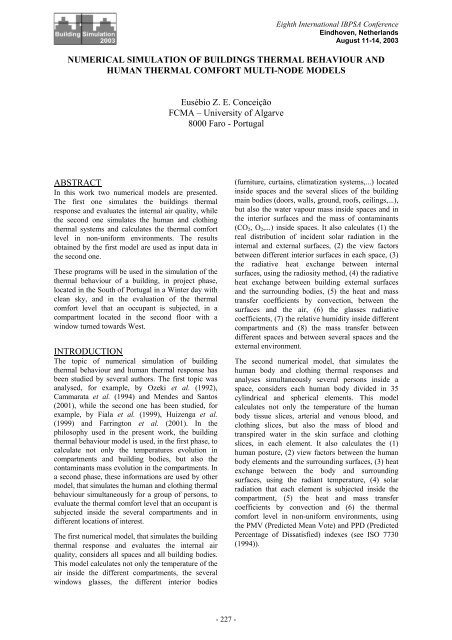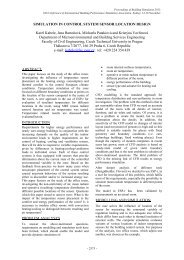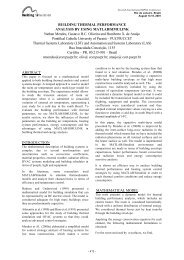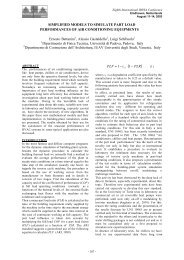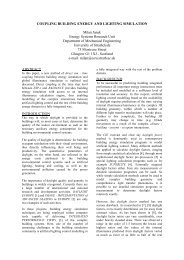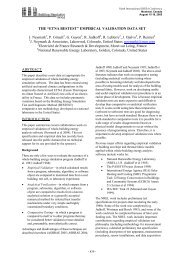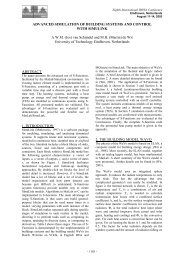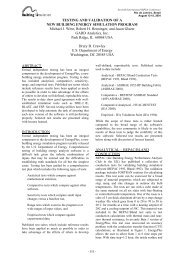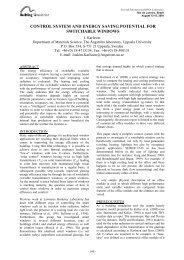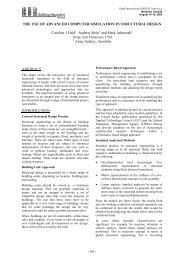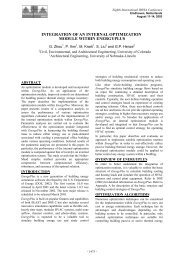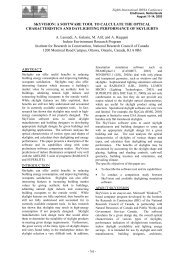numerical simulation of buildings thermal behaviour and ... - ibpsa
numerical simulation of buildings thermal behaviour and ... - ibpsa
numerical simulation of buildings thermal behaviour and ... - ibpsa
Create successful ePaper yourself
Turn your PDF publications into a flip-book with our unique Google optimized e-Paper software.
NUMERICAL SIMULATION OF BUILDINGS THERMAL BEHAVIOUR AND<br />
HUMAN THERMAL COMFORT MULTI-NODE MODELS<br />
ABSTRACT<br />
In this work two <strong>numerical</strong> models are presented.<br />
The first one simulates the <strong>buildings</strong> <strong>thermal</strong><br />
response <strong>and</strong> evaluates the internal air quality, while<br />
the second one simulates the human <strong>and</strong> clothing<br />
<strong>thermal</strong> systems <strong>and</strong> calculates the <strong>thermal</strong> comfort<br />
level in non-uniform environments. The results<br />
obtained by the first model are used as input data in<br />
the second one.<br />
These programs will be used in the <strong>simulation</strong> <strong>of</strong> the<br />
<strong>thermal</strong> <strong>behaviour</strong> <strong>of</strong> a building, in project phase,<br />
located in the South <strong>of</strong> Portugal in a Winter day with<br />
clean sky, <strong>and</strong> in the evaluation <strong>of</strong> the <strong>thermal</strong><br />
comfort level that an occupant is subjected, in a<br />
compartment located in the second floor with a<br />
window turned towards West.<br />
INTRODUCTION<br />
The topic <strong>of</strong> <strong>numerical</strong> <strong>simulation</strong> <strong>of</strong> building<br />
<strong>thermal</strong> <strong>behaviour</strong> <strong>and</strong> human <strong>thermal</strong> response has<br />
been studied by several authors. The first topic was<br />
analysed, for example, by Ozeki et al. (1992),<br />
Cammarata et al. (1994) <strong>and</strong> Mendes <strong>and</strong> Santos<br />
(2001), while the second one has been studied, for<br />
example, by Fiala et al. (1999), Huizenga et al.<br />
(1999) <strong>and</strong> Farrington et al. (2001). In the<br />
philosophy used in the present work, the building<br />
<strong>thermal</strong> <strong>behaviour</strong> model is used, in the first phase, to<br />
calculate not only the temperatures evolution in<br />
compartments <strong>and</strong> building bodies, but also the<br />
contaminants mass evolution in the compartments. In<br />
a second phase, these informations are used by other<br />
model, that simulates the human <strong>and</strong> clothing <strong>thermal</strong><br />
<strong>behaviour</strong> simultaneously for a group <strong>of</strong> persons, to<br />
evaluate the <strong>thermal</strong> comfort level that an occupant is<br />
subjected inside the several compartments <strong>and</strong> in<br />
different locations <strong>of</strong> interest.<br />
The first <strong>numerical</strong> model, that simulates the building<br />
<strong>thermal</strong> response <strong>and</strong> evaluates the internal air<br />
quality, considers all spaces <strong>and</strong> all building bodies.<br />
This model calculates not only the temperature <strong>of</strong> the<br />
air inside the different compartments, the several<br />
windows glasses, the different interior bodies<br />
Eusébio Z. E. Conceição<br />
FCMA – University <strong>of</strong> Algarve<br />
8000 Faro - Portugal<br />
- 227 -<br />
Eighth International IBPSA Conference<br />
Eindhoven, Netherl<strong>and</strong>s<br />
August 11-14, 2003<br />
(furniture, curtains, climatization systems,...) located<br />
inside spaces <strong>and</strong> the several slices <strong>of</strong> the building<br />
main bodies (doors, walls, ground, ro<strong>of</strong>s, ceilings,...),<br />
but also the water vapour mass inside spaces <strong>and</strong> in<br />
the interior surfaces <strong>and</strong> the mass <strong>of</strong> contaminants<br />
(CO2, O2,...) inside spaces. It also calculates (1) the<br />
real distribution <strong>of</strong> incident solar radiation in the<br />
internal <strong>and</strong> external surfaces, (2) the view factors<br />
between different interior surfaces in each space, (3)<br />
the radiative heat exchange between internal<br />
surfaces, using the radiosity method, (4) the radiative<br />
heat exchange between building external surfaces<br />
<strong>and</strong> the surrounding bodies, (5) the heat <strong>and</strong> mass<br />
transfer coefficients by convection, between the<br />
surfaces <strong>and</strong> the air, (6) the glasses radiative<br />
coefficients, (7) the relative humidity inside different<br />
compartments <strong>and</strong> (8) the mass transfer between<br />
different spaces <strong>and</strong> between several spaces <strong>and</strong> the<br />
external environment.<br />
The second <strong>numerical</strong> model, that simulates the<br />
human body <strong>and</strong> clothing <strong>thermal</strong> responses <strong>and</strong><br />
analyses simultaneously several persons inside a<br />
space, considers each human body divided in 35<br />
cylindrical <strong>and</strong> spherical elements. This model<br />
calculates not only the temperature <strong>of</strong> the human<br />
body tissue slices, arterial <strong>and</strong> venous blood, <strong>and</strong><br />
clothing slices, but also the mass <strong>of</strong> blood <strong>and</strong><br />
transpired water in the skin surface <strong>and</strong> clothing<br />
slices, in each element. It also calculates the (1)<br />
human posture, (2) view factors between the human<br />
body elements <strong>and</strong> the surrounding surfaces, (3) heat<br />
exchange between the body <strong>and</strong> surrounding<br />
surfaces, using the radiant temperature, (4) solar<br />
radiation that each element is subjected inside the<br />
compartment, (5) the heat <strong>and</strong> mass transfer<br />
coefficients by convection <strong>and</strong> (6) the <strong>thermal</strong><br />
comfort level in non-uniform environments, using<br />
the PMV (Predicted Mean Vote) <strong>and</strong> PPD (Predicted<br />
Percentage <strong>of</strong> Dissatisfied) indexes (see ISO 7730<br />
(1994)).
INPUT DATA<br />
The input data used by the <strong>buildings</strong> <strong>thermal</strong><br />
<strong>behaviour</strong> model are the tridimensional geometry, the<br />
materials <strong>thermal</strong> proprieties <strong>and</strong> other conditions.<br />
Firstly, all spaces are identified. The compartments<br />
geometry is defined through the introduction <strong>of</strong><br />
involving bodies: building main bodies <strong>and</strong> windows<br />
glasses bodies. These bodies, with complex<br />
geometry, that are associated to the boundary <strong>of</strong> two<br />
compartments (or <strong>of</strong> a compartment <strong>and</strong> the external<br />
environment), are flat. As the main bodies are<br />
divided in several slices, in order to simulate the<br />
<strong>thermal</strong> stratification verified in these bodies, it is<br />
also necessary to identify the slices thickness. In the<br />
compartments geometry is important to introduce the<br />
more relevant interior bodies in the <strong>simulation</strong>. In the<br />
second part, are introduced the main bodies,<br />
windows glasses <strong>and</strong> interior bodies <strong>thermal</strong><br />
proprieties. Finally, it is also necessary to introduce<br />
the external environmental <strong>and</strong> geographical<br />
conditions, the initial conditions <strong>of</strong> the <strong>simulation</strong>,<br />
the heat load released by the human bodies, heating<br />
<strong>and</strong> air-conditioning systems (<strong>and</strong> other internal<br />
sources), air recirculation, air exchanges between<br />
compartments, air exchange between each<br />
compartment <strong>and</strong> the external environment <strong>and</strong> to<br />
identify the internal mass generation <strong>and</strong> its intensity.<br />
The results obtained by the first model, which are<br />
associated to the air mean temperature <strong>and</strong> relative<br />
humidity in the compartment, the surrounding<br />
surfaces temperatures, solar radiation <strong>and</strong><br />
compartment geometry, are used as input data to the<br />
second model. It is also needed to introduce the<br />
occupant’s location <strong>and</strong> to define their postures. The<br />
air velocity around the occupants is also possible to<br />
introduce.<br />
Using these input data the programs built one energy<br />
<strong>and</strong> mass balance integral equations system for the<br />
building <strong>and</strong> a second one for the occupants. In the<br />
resolution <strong>of</strong> these systems is used the Runge-Kutta-<br />
Fehlberg method with error control (see Burden <strong>and</strong><br />
Faires (1985)). The s<strong>of</strong>tware can also visualise the<br />
building <strong>and</strong> occupant geometry or export a file to be<br />
seen in a compatible code.<br />
BUILDING THERMAL BEHAVIOR<br />
The <strong>buildings</strong> <strong>thermal</strong> <strong>behaviour</strong> multi-node model,<br />
that works in transient conditions, is based in energy<br />
<strong>and</strong> mass balance integral equations. The energy<br />
balance integral equation are developed for the air<br />
inside compartments, the windows glasses, the<br />
interior bodies located inside spaces <strong>and</strong> the different<br />
building main bodies, while the mass balance integral<br />
equations are developed for the water vapour inside<br />
spaces <strong>and</strong> in the interior surfaces (main bodies,<br />
windows glasses <strong>and</strong> interior bodies) <strong>and</strong> air<br />
- 228 -<br />
contaminants (CO2, O2, ...) inside spaces. This kind<br />
<strong>of</strong> equations, applied in <strong>buildings</strong>, had been used by<br />
several authors, for example, by Cammarata et al.<br />
(1994), Str<strong>and</strong> et al. (2001) <strong>and</strong> Mendes <strong>and</strong> Santos<br />
(2001).<br />
The model considers the conductive phenomena<br />
between different slices <strong>of</strong> the main bodies. In the<br />
ground is imposed a fixed temperature at a<br />
predefined dept.<br />
There are considered natural, forced <strong>and</strong> mixed<br />
convection phenomena between the internal <strong>and</strong><br />
external <strong>buildings</strong> surfaces <strong>and</strong> the adjacent fluid. In<br />
the determination <strong>of</strong> the heat transfer coefficient by<br />
convection are used empirical expressions published<br />
in specialised bibliography (see, for example, Guyer<br />
<strong>and</strong> Brownell (1999)).<br />
The mass transport phenomena (water vapour <strong>and</strong><br />
other gases) are divided in four parts: mass exchange<br />
between different compartments (1), mass exchange<br />
between each space <strong>and</strong> the external environment (2)<br />
<strong>and</strong> mass generation inside spaces (human<br />
respiration <strong>and</strong> transpiration) (3) (see Berne (1994)).<br />
In the water vapour transport are also considered the<br />
mass exchange between the internal surfaces <strong>and</strong> the<br />
air inside spaces (4). Using the water vapour mass<br />
values <strong>and</strong> the air temperature values the model<br />
calculates the air relative humidity (see ASHRAE<br />
H<strong>and</strong>book (2001)).<br />
Finally, the radiative phenomena (verified inside <strong>and</strong><br />
outside the building), in the present model, are<br />
divided in short-wave <strong>and</strong> long-wave radiation.<br />
In short-wave radiation, associated to the solar<br />
radiation, it is calculated the real distribution <strong>of</strong> the<br />
solar radiation not only in external surfaces (main<br />
bodies <strong>and</strong> windows glasses), but also in the internal<br />
surfaces (main <strong>and</strong> interior bodies). In the external<br />
surfaces (see figure 1a) are calculated the absorbed<br />
<strong>and</strong> reflected radiation in the main bodies <strong>and</strong> the<br />
absorbed, reflected <strong>and</strong> transmitted radiation in the<br />
windows glasses, while in the interior surfaces (see<br />
figure 1b), using the transmitted solar radiation<br />
through the glasses, are calculated the absorbed <strong>and</strong><br />
reflected radiation in the main <strong>and</strong> interior bodies<br />
surfaces (see Ozeki et al. (1992)).<br />
In the long-wave radiation, the model considers not<br />
only the heat exchange between the building external<br />
surfaces <strong>and</strong> the nocturnal sky <strong>and</strong> the surrounding<br />
surfaces (other <strong>buildings</strong>, vegetation,...), during the<br />
day, but also heat exchange between the internal<br />
surfaces (main bodies, windows glasses <strong>and</strong> interior<br />
bodies) <strong>of</strong> each space (see figure 2). The diffuse<br />
radiation between grey surfaces, in each enclosure, is<br />
calculated through the radiosity method, through the
view factors <strong>and</strong> the surfaces temperature (see Ozeki<br />
et al. (1992)).<br />
b)<br />
With external shading effect<br />
With internal shading effect<br />
Without shading effect<br />
Sun direction<br />
Figure 1 – Scheme <strong>of</strong> the real distribution <strong>of</strong> solar<br />
radiation in external (a) <strong>and</strong> internal (b) surfaces with<br />
<strong>and</strong> without shading effect.<br />
b)<br />
Figure 2 – Scheme used in the internal long-wave<br />
radiation with (a) <strong>and</strong> without (b) shading effect.<br />
In the radiative calculus, <strong>of</strong> long-wave <strong>and</strong> shortwave<br />
radiations, are considered the shading effect<br />
a)<br />
a)<br />
- 229 -<br />
caused by the surrounding surfaces (<strong>buildings</strong> or<br />
other obstacles) <strong>and</strong> by internal surfaces (main <strong>and</strong><br />
interior bodies in each compartment) (see Corrado et<br />
al. (1995)). In these calculus all building surfaces<br />
(main bodies, windows glasses <strong>and</strong> interior bodies)<br />
are sub-divided in several small areas (see figures 1<br />
<strong>and</strong> 2).<br />
HUMAN THERMAL COMFORT<br />
In the human <strong>thermal</strong> comfort multi-node model, that<br />
works in transient conditions <strong>and</strong> simultaneously<br />
simulates a group <strong>of</strong> persons, the tridimentional body<br />
is divided in 34 cylindrical <strong>and</strong> 1 spherical elements.<br />
Each element is sub-divided in 12 cylindrical (or<br />
spherical) slices <strong>and</strong> could be still protected from the<br />
external environment through some clothing slices.<br />
More details about this simplified human body can<br />
be analysed, for example, in Conceição (2000),<br />
Conceição <strong>and</strong> Lúcio (2001) or in Conceição <strong>and</strong><br />
Lúcio (2002).<br />
The human <strong>thermal</strong> response is based on energy<br />
balance integral equations for the human body tissue<br />
slices <strong>and</strong> arterial <strong>and</strong> venous blood, as well as mass<br />
balance integral equations for the blood <strong>and</strong><br />
transpired water in the skin surface for each element.<br />
The clothing <strong>thermal</strong> response is based on energy<br />
balance integral equations for the clothing slices, as<br />
well as mass balance integral equations for the<br />
clothing slices in each element. These integral<br />
equations are based in the following phenomena (see<br />
Conceição (2000)): internal metabolism, heat<br />
conduction through the tissue, blood circulatory<br />
convection, heat loss by respiration to the<br />
environment, heat exchange between the body <strong>and</strong><br />
the environment (or clothing) by radiation,<br />
convection, conduction <strong>and</strong> evaporation. To control<br />
the human body temperature is implemented a<br />
model, based in Stolwijk (1970), that simulates the<br />
thermo-regulatory system.<br />
The human body, inside an internal space, is<br />
subjected to short-wave to long-wave radiations. In<br />
this calculus the 35 human body elements <strong>and</strong> the<br />
surrounding external surfaces are divided in small<br />
areas. More details about the grid generation around<br />
the human body <strong>and</strong> in the surrounding surfaces, in<br />
complex topology, can be analysed in Conceição<br />
(2003). The philosophy used in the short-wave<br />
radiation calculus, with the parallel ray method (see,<br />
for example, Ozeki et al. (1998)), can be seen in<br />
figure 3 (a1, b1 <strong>and</strong> c1). To calculate the heat<br />
exchange by radiation between the human body<br />
external surface <strong>and</strong> the surrounding surfaces are<br />
used the mean radiant temperature (see Fanger<br />
(1970)). These calculus are based in the view factors<br />
<strong>and</strong> in the surrounding surface temperatures (see<br />
figure 3 (a2, b2 <strong>and</strong> c2)). In the radiative calculus,
long-wave <strong>and</strong> short-wave radiations, were<br />
considered the shading effect <strong>of</strong> the human body<br />
elements (see figure 3b) <strong>and</strong> the surrounding surfaces<br />
(see figure 3c) (see Corrado et al. (1995)).<br />
To evaluate the <strong>thermal</strong> comfort level, in steady state<br />
conditions, are used the PMV <strong>and</strong> PPD indexes,<br />
presented by Fanger (1970). These indexes are based<br />
in the heat flux exchanged between the body <strong>and</strong> the<br />
environment (see also Miyanaga <strong>and</strong> Nakamo<br />
(1998)).<br />
c1<br />
b1<br />
c2<br />
a1<br />
a2<br />
b2<br />
Figure 3 – Scheme <strong>of</strong> short-wave (number 1) <strong>and</strong><br />
long-wave (number 2) radiations, without (a) <strong>and</strong><br />
with shading effect caused by the human body<br />
elements (b) <strong>and</strong> the surrounding surfaces (c).<br />
NUMERICAL SIMULATION<br />
In this work these models are used to simulate the<br />
<strong>thermal</strong> <strong>behaviour</strong> <strong>of</strong> a building, with complex<br />
geometry, <strong>and</strong> to evaluate the global <strong>thermal</strong> comfort<br />
level, in a non-uniform environment. The idea is to<br />
use the results obtained in the first model (related<br />
with the surrounding surfaces temperature field, the<br />
air temperature <strong>and</strong> relative humidity, <strong>and</strong> the solar<br />
radiation in the occupied space <strong>and</strong> the compartment<br />
geometry), in the second model to evaluate the<br />
human <strong>thermal</strong> comfort level in a specified situation.<br />
Building Thermal <strong>behaviour</strong><br />
This <strong>numerical</strong> model, that also was used <strong>and</strong><br />
validated in multi-nodal vehicles (see Conceição<br />
(2001)), after being validated with some preliminary<br />
experimental tests in <strong>buildings</strong>, was used to evaluate<br />
the <strong>thermal</strong> response <strong>of</strong> a building, in project phase,<br />
located in the South <strong>of</strong> Portugal during a Winter day<br />
with clean sky. In this building (see figure 4),<br />
divided in 11 compartments, were considered 118<br />
main bodies, 8 window glasses <strong>and</strong> 4 interior bodies<br />
- 230 -<br />
(stairs located in the first floor <strong>and</strong> a desk located in<br />
the second floor).<br />
In the main bodies, windows glasses <strong>and</strong> interior<br />
bodies was used a composition similar to real<br />
<strong>buildings</strong> in this country.<br />
In the beginning <strong>of</strong> the <strong>simulation</strong> were calculated,<br />
inside the 11 spaces, 3890 view factors. In this<br />
calculus each surface was divided in areas not higher<br />
than 0.25×0.25 m 2 . In figure 5 is presented the grid<br />
generation used in the short-wave <strong>and</strong> long-wave<br />
radiative calculus in the building. In the building<br />
<strong>thermal</strong> <strong>simulation</strong> <strong>of</strong> air recirculation <strong>and</strong><br />
renovation, the heat <strong>and</strong> mass sources in spaces, the<br />
heating systems <strong>and</strong> the human heat load were not<br />
considered. The doors <strong>and</strong> windows were closed <strong>and</strong><br />
the windows shading devices had not been<br />
considered in this calculus.<br />
Figure 4 - Scheme <strong>of</strong> the analysed building. The<br />
horizontal <strong>and</strong> vertical numbers are associated,<br />
respectively, to compartments <strong>and</strong> windows<br />
locations.<br />
Figure 5 – Scheme <strong>of</strong> grid generation used in the<br />
radiative calculus in the building.
The air temperature (see figure 6) <strong>and</strong> relative<br />
humidity (see figure 7), in the external environment,<br />
was obtained experimentally in a Winter typical day.<br />
During the experimental test the sky remained clean<br />
<strong>and</strong> there was no wind.<br />
In figure 8 are presented the evolutions <strong>of</strong> air mean<br />
temperatures inside the compartments 1 (in the first<br />
floor, with a window turned towards South), 3 (in the<br />
first floor, with a window turned towards North), 7<br />
(in the first floor, with a window turned towards<br />
East), 8 (in the second floor, with a window turned<br />
towards West) <strong>and</strong> 9 (in the second floor, with a<br />
window turned towards South). In this <strong>simulation</strong>,<br />
done in 5 th February, it was also considered the five<br />
previous days, to evaluate the heat stored in building<br />
materials. The evolution <strong>of</strong> the glasses temperature in<br />
the windows 1, 2, 4, 6 <strong>and</strong> 7 is presented in figure 9.<br />
T (ºC)<br />
18<br />
17<br />
16<br />
15<br />
14<br />
13<br />
12<br />
11<br />
10<br />
0 2 4 6 8 10 12 14 16 18 20 22 24<br />
t (hours)<br />
Figure 6 – Air temperature in the external<br />
environment obtained experimentally in a winter<br />
typical day with clean sky.<br />
RH (%)<br />
80<br />
70<br />
60<br />
50<br />
40<br />
30<br />
0 2 4 6 8 10 12 14 16 18 20 22 24<br />
t (hours)<br />
Figure 7 – Air relative humidity in the external<br />
environment obtained experimentally in a winter<br />
typical day with clean sky.<br />
- 231 -<br />
T (ºC)<br />
T (ºC)<br />
28<br />
26<br />
24<br />
22<br />
20<br />
18<br />
9<br />
16<br />
0 2 4 6 8 10 12 14 16 18 20 22 24<br />
1<br />
3<br />
t (hours)<br />
Figure 8 - Evolution <strong>of</strong> the air mean temperature<br />
inside the compartments 1, 3, 7, 8 <strong>and</strong> 9.<br />
25<br />
23<br />
21<br />
19<br />
17<br />
15<br />
4<br />
13<br />
0 2 4 6 8 10 12 14 16 18 20 22 24<br />
6<br />
7<br />
t (hours)<br />
Figure 9 - Evolution <strong>of</strong> the glasses temperature in the<br />
windows 1, 2, 4, 6 <strong>and</strong> 7.<br />
The results obtained in the first part <strong>of</strong> this study,<br />
related to the building <strong>thermal</strong> <strong>behaviour</strong>, show that:<br />
- in general, the air temperature values are the<br />
lowest in compartments with windows turned<br />
towards North <strong>and</strong> the highest in compartments<br />
with windows turned towards South;<br />
- the air temperature values in compartments<br />
located in the second floor, in general, are higher<br />
than in compartments located in the first floor;<br />
- the glasses temperature, in general, are the<br />
highest for windows turned towards South.<br />
Nevertheless, when they are shaded by building<br />
bodies this is not verified (see the glass<br />
temperature evolution for the window 2 after<br />
13.30 p.m.).<br />
Human Thermal Comfort<br />
After being validated, with experimental data<br />
obtained in laboratory <strong>and</strong> presented in specialised<br />
bibliography (see, for example, Conceição <strong>and</strong> Lúcio<br />
(2001)), the model is used to evaluate the <strong>thermal</strong><br />
comfort level that an occupant is subjected in the<br />
compartment 8, when is seated in the desk near (see<br />
2<br />
1<br />
8<br />
7
figure 10a) <strong>and</strong> far from (see figure 10b) the<br />
window. After being verified that the solar radiation<br />
field that an occupant is subjected (when is seated in<br />
the desk near the window) is highest around 16 p.m.,<br />
was decided to analyse the human <strong>thermal</strong> comfort at<br />
this hour.<br />
Figure 11 shows the grid generation in the external<br />
surface <strong>of</strong> the seated occupant.<br />
a)<br />
b)<br />
Figure 10 – Scheme <strong>of</strong> the location <strong>of</strong> the occupant<br />
in the compartment 8, when he is seated near (a) <strong>and</strong><br />
far from (b) the window.<br />
Figure 11 – Grid generation in the seated occupant’s<br />
body external surface.<br />
- 232 -<br />
The occupant considered was 1.7 m <strong>of</strong> height, 70 Kg<br />
<strong>of</strong> weight, 1.2 met <strong>of</strong> activity <strong>and</strong> 1.1 Clo <strong>of</strong> clothing<br />
level (light underwear, shirt with long sleeves,<br />
pullover, long trousers, light socks <strong>and</strong> shoes). The<br />
air temperature <strong>and</strong> relative humidity, calculated by<br />
the <strong>buildings</strong> <strong>thermal</strong> <strong>behaviour</strong> multi-node model,<br />
were 21.9 ºC <strong>and</strong> 42.2 %, respectively. The radiant<br />
mean temperature <strong>and</strong> the solar radiation flux,<br />
calculated by the human comfort multi-node model,<br />
are presented in the figures 12 <strong>and</strong> 13, respectively.<br />
Finally, the PMV <strong>and</strong> the PPD indexes, that the<br />
occupant is subjected at 16 p.m., when is seated near<br />
<strong>and</strong> far from the window, are presented in table 1.<br />
T (ºC)<br />
21,2<br />
21,1<br />
21,0<br />
20,9<br />
20,8<br />
20,7<br />
20,6<br />
20,5<br />
Head<br />
Neck<br />
Chest<br />
Upper abdomen<br />
Lower abdomen<br />
Right upper arm<br />
Right lower arm<br />
Right upper forearm<br />
Right lower forearm<br />
Right h<strong>and</strong><br />
Left upper arm<br />
Left lower arm<br />
Left upper forearm<br />
Left lower forearm<br />
Left h<strong>and</strong><br />
Right upper thigh<br />
Near the window<br />
Far from the window<br />
Figure 12 – Radiant mean temperature in the human<br />
body elements, when the occupant is seated near <strong>and</strong><br />
far from the window.<br />
I (W)<br />
35<br />
30<br />
25<br />
20<br />
15<br />
10<br />
5<br />
0<br />
Head<br />
Neck<br />
Chest<br />
Upper abdomen<br />
Lower abdomen<br />
Right upper arm<br />
Right lower arm<br />
Right upper forearm<br />
Right lower forearm<br />
Right h<strong>and</strong><br />
Left upper arm<br />
Left lower arm<br />
Left upper forearm<br />
Left lower forearm<br />
Left h<strong>and</strong><br />
Right lower thigh<br />
Right upper thigh<br />
Right lower thigh<br />
Right upper leg<br />
Right lower leg<br />
Right foot<br />
Right upper leg<br />
Right lower leg<br />
Right foot<br />
Left upper thigh<br />
Left lower thigh<br />
Left upper thigh<br />
Left lower thigh<br />
Left upper leg<br />
Left lower leg<br />
Left foot<br />
Left upper leg<br />
Left lower leg<br />
Left foot<br />
Figure 13 – Solar radiation flux in the human body<br />
elements, when he is seated near the window.<br />
Table 1 – PMV <strong>and</strong> PPD indexes that an occupant is<br />
subjected near <strong>and</strong> far from the window.<br />
Location PMV PPD (%)<br />
Near the window 1.2 35.2<br />
Far from the window -0.3 7.2<br />
The analysis <strong>of</strong> the results shows that:<br />
- the radiant mean temperature field that an<br />
occupant is subjected is lightly higher near the<br />
window than far from the window. This value is
lightly higher in the body right side than in the<br />
left side. Nevertheless, this asymmetry is not very<br />
significant;<br />
- the occupant seated in the desk near the window<br />
is subjected to direct solar radiation in the head,<br />
neck, chest <strong>and</strong> upper members. In the abdomen<br />
<strong>and</strong> inferior members the solar radiation is<br />
shading by the desk;<br />
- in accord to ISO 7730 (1994), the occupant<br />
seated near the window is <strong>thermal</strong>ly<br />
uncomfortable. Nevertheless, when he is far from<br />
the window, not subjected to solar radiation, he is<br />
in <strong>thermal</strong> comfort conditions.<br />
CONCLUSIONS<br />
In this work two <strong>numerical</strong> models, that evaluate<br />
respectively the <strong>buildings</strong> <strong>thermal</strong> <strong>behaviour</strong> <strong>and</strong> the<br />
human <strong>thermal</strong> comfort, were presented. The first<br />
one was used in the <strong>thermal</strong> study <strong>of</strong> a building, with<br />
two floors, located in the South <strong>of</strong> Portugal in a<br />
Winter day with clean sky. The second one was used<br />
in the evaluation <strong>of</strong> <strong>thermal</strong> comfort level that an<br />
occupant is subjected, when he is seated in a<br />
compartment with a window turned towards West.<br />
It was verified that at 16 p.m., when the occupant is<br />
seated near the window, uncomfortable conditions<br />
were obtained. Nevertheless, if the occupant is not<br />
subjected to direct solar radiation, the comfort<br />
<strong>thermal</strong> conditions are obtained.<br />
These models, in collaboration, can be used to<br />
develop <strong>buildings</strong> <strong>thermal</strong>ly efficient with optimised<br />
<strong>thermal</strong> comfort levels. They are a very important<br />
tool to be used not only in the study <strong>of</strong> special<br />
compartments, like <strong>of</strong>fices, classrooms <strong>and</strong> atria, for<br />
example, where is important to create good comfort<br />
conditions for seated occupants, but also in the<br />
project <strong>of</strong> localised heating, ventilation, air<br />
conditioning <strong>and</strong> radiant panel systems, in nonuniform<br />
environments.<br />
In this work was not analysed the local discomfort<br />
level. This topic will be done in future studies. The<br />
building <strong>thermal</strong> <strong>behaviour</strong> model, in the near future<br />
research, will be subjected to more experimental tests<br />
in <strong>buildings</strong> with complex topology.<br />
ACKNOWLEDGEMENT<br />
The author acknowledges the support by<br />
INOVALGARVE program, CCR-Alg <strong>and</strong><br />
DREALG, sponsored by the European comunitary<br />
fund FEDER.<br />
Part <strong>of</strong> this research activity is also being developed<br />
inside a project approved <strong>and</strong> financed by the FCT<br />
- 233 -<br />
<strong>and</strong> POCTI, sponsored by the European comunitary<br />
fund FEDER.<br />
REFERENCES<br />
ASHRAE H<strong>and</strong>book, “Fundamentals”, American<br />
Society <strong>of</strong> Heating, Refrigerating <strong>and</strong> Air-<br />
Conditioning Engineers, Inc., Atlanta, USA, 2001.<br />
Berne, Ph., “Prediction <strong>of</strong> the Concentration Decay<br />
in a Ventilated Enclosure by the Multi-zone Model”,<br />
RoomVent 1994 - 4th Int. Conference on Air<br />
Distribution in Rooms, Kraków, Pol<strong>and</strong>, 1994.<br />
Burden, R. L. <strong>and</strong> Faires, J. D., “Numerical<br />
Analysis”, Prindle, Weber & Schmidt, Boston, USA,<br />
1985.<br />
Cammarata, G.; Fichera, A.; Forgia. F.; Marletta, L.<br />
<strong>and</strong> Muscato, G., “Thermal Load Buildings General<br />
Models <strong>and</strong> Reduce Models”, Healthy Buildings<br />
1994, Proc. <strong>of</strong> the 3 rd Int. Conference, Budapest,<br />
Hungary, 1994.<br />
Conceição, E. Z. E. <strong>and</strong> Lúcio, Mª M. J. R.,<br />
“Influence <strong>of</strong> Non-Uniform Airflow from Different<br />
Directions in the Thermal Comfort Level in Seated<br />
Persons”, RoomVent 2002 - 8th Int Conference on<br />
Air Distribution in Rooms, Copenhagen, Denmark,<br />
2002<br />
Conceição, E. Z. E. <strong>and</strong> Lúcio, Mª M. J. R.,<br />
“Numerical <strong>and</strong> Subjective Responses <strong>of</strong> Human<br />
Thermal Sensation”, BioEng 2001, 6 th Portuguese<br />
Conference on Biomedical Engeering, University <strong>of</strong><br />
Algarve, Faro, Portugal, 2001.<br />
Conceição, E. Z. E., “Evaluation <strong>of</strong> Thermal Comfort<br />
<strong>and</strong> Local Discomfort Conditions Using the<br />
Numerical Modelling <strong>of</strong> the Human <strong>and</strong> Clothing<br />
Thermal System”, RoomVent 2000 - 7 th Int.<br />
Conference on Air Distribution in Rooms, University<br />
<strong>of</strong> Reading, United Kingdom, 2000.<br />
Conceição, E. Z. E., “Geração de Malha em Torno de<br />
Ocupantes em Compartimentos com Topologia<br />
Complexa”, VII Congresso de Mecânia Aplicada e<br />
Computacional, University <strong>of</strong> Évora, Évora,<br />
Portugal, 2003.<br />
Conceição, E. Z. E., “Multi-nodal Models <strong>of</strong><br />
Vehicles Thermal Behaviour <strong>and</strong> Passenger Thermal<br />
Response”, Florence ATA 2001 - 7th Int.<br />
Conference, Florence, Italy, 2001.<br />
Corrado, C.; Pretti, M. <strong>and</strong> Sacchi, A. “Routine for<br />
Calculation <strong>of</strong> Angle Factors Between Human Body<br />
<strong>and</strong> Car Driver’s Cabin”, Proc. ATA Congress,<br />
Bologne, Italy, 1995.
Fanger, P. O., “Thermal Comfort: Analysis <strong>and</strong><br />
Applications in Environmental Engineering”,<br />
McGraw-Hill Book Company, USA, 1970.<br />
Farrington, R; Barber, G.; Hendrichs, T.; Marion,<br />
W.; Markel, T.; McGuffin, R. <strong>and</strong> Rugh, J., “Integred<br />
Modeling to Predict Occupant Thermal Comfort”,<br />
Florence ATA 2001 - 7th Int. Conference, Florence,<br />
Italy, 2001.<br />
Fiala, D.; Lomas, K. J. <strong>and</strong> Stohrer, M., “A<br />
Computer Model <strong>of</strong> Human Thermoregulation for a<br />
Wide Range <strong>of</strong> Environmental Conditions: the<br />
Passive System”, Journal <strong>of</strong> Applied Physiology,<br />
Vol. 87, Issue 5, November, pp.1957-1972, 1999.<br />
Guyer, E. C. <strong>and</strong> Brownell, D. L., “H<strong>and</strong>book <strong>of</strong><br />
Applied Thermal Design”, Taylor & Francis,<br />
Philadelphia, USA, 1999.<br />
Huizenga, C.; Hui, Z. ; Duan, T. <strong>and</strong> Arens, E., “An<br />
Improved Multinode <strong>of</strong> Human Physiology <strong>and</strong><br />
Thermal Comfort”, in Proc. <strong>of</strong> 6 th Int. IBPSA<br />
Conference Building Simulation 1999, Vol. 1, pp.<br />
353-359, 1999.<br />
ISO 7730, “Moderate Thermal Environments -<br />
Determination <strong>of</strong> the PMV <strong>and</strong> PPD Indices <strong>and</strong><br />
Specification <strong>of</strong> the Conditions for Thermal<br />
Comfort”, International Organisation for<br />
Normalisation, Switzerl<strong>and</strong>, 1994.<br />
Mendes, N. <strong>and</strong> Santos, G. H., “Dynamic Analysis <strong>of</strong><br />
building Hygro<strong>thermal</strong> Behavior”, in Proc. <strong>of</strong> 7 th Int.<br />
IBPSA Conference Building Simulation 2001, Vol.<br />
1, pp. 117-123, 2001.<br />
Miyanaga, T. <strong>and</strong> Nakamo, Y., “Analysis <strong>of</strong> Thermal<br />
Sensation in a Radiant Cooled Room by Modified<br />
PMV”, RoomVent 1998 - 6th Int. Conference on Air<br />
Distribution in Rooms, KTH, Stockholm, Sweden,<br />
1998.<br />
Ozeki, Y.; Konishi, M.; Narita. C. <strong>and</strong> Tanabe, S.,<br />
“Effective Radiation Area <strong>of</strong> Human Body<br />
Calculated by a Numerical Simulation”, RoomVent<br />
1998 - 6 th Int. Conference on Air Distribution in<br />
Rooms, Stockholm, Sweden, 1998.<br />
Ozeki, Y.; Yamamoto, M.; Saito, T.; Ohgaki, S. <strong>and</strong><br />
Sonda, Y., “Simulation on Temperature <strong>and</strong> Flow<br />
Field in the Atrium (Part1. Computation <strong>of</strong> Solar<br />
Radiation, Radiative Heat Transfer, Air Flow, <strong>and</strong><br />
Temperature”, RoomVent 1992 – 3 rd Int.<br />
Conference on Air Distribution in Rooms, Aalborg,<br />
Denmark, 1992.<br />
Stolwijk, J. A. J. “Mathematical Model <strong>of</strong><br />
Thermoregulation”, in Hardy, J. D., Gagge, A. P. <strong>and</strong><br />
Stolwijk, J. A. J. “Physiological <strong>and</strong> Behaviour<br />
Thermoregulation”, Thomas, Springfield, pp. 703-<br />
721, 1970.<br />
- 234 -<br />
Str<strong>and</strong>, R. K.; Pedersen, C. O. <strong>and</strong> Crawley, D. B.,<br />
“Modularization <strong>and</strong> Simulation Techniques for Heat<br />
Balance Based Energy <strong>and</strong> Loads Calculation<br />
Programs: the Experience <strong>of</strong> the ASHRAE Loads<br />
Toolkit <strong>and</strong> Energyplus”, in Proc. <strong>of</strong> 7 th Int. IBPSA<br />
Conference Building Simulation 2001, Vol. 1, pp.<br />
43-50, 2001.


